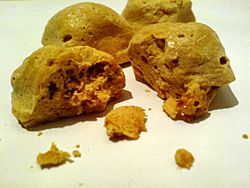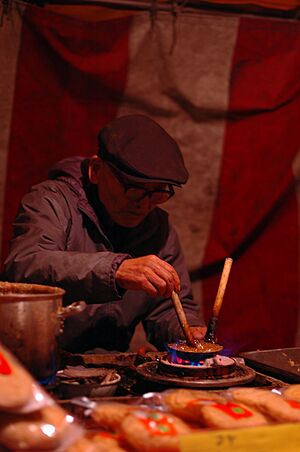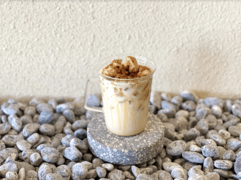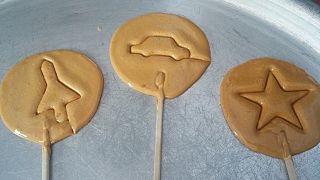Honeycomb toffee facts for kids
 |
|
| Alternative names | Sponge Candy, Sponge toffee, cinder toffee, seafoam, golden crunchers, hokey pokey |
|---|---|
| Type | Toffee |
| Main ingredients | Brown sugar, corn syrup (or molasses or golden syrup), baking soda |
Honeycomb toffee is a super sweet candy. It has a light, bubbly texture, almost like a sponge! That's why it's also called sponge toffee or cinder toffee. In New Zealand, it's known as hokey pokey.
This yummy treat is usually made from brown sugar, corn syrup, and baking soda. Sometimes, a little bit of vinegar is added too. When the baking soda mixes with the hot sugar, it creates tiny bubbles of gas. These bubbles get trapped in the candy, making it light and airy. As the candy cools, it becomes hard and crunchy.
Making honeycomb toffee is quite simple and quick. Because of this, many families enjoy making it at home. It's a fun recipe for kids to try! You can also buy it in stores, often in small blocks. Sometimes, it's even covered in chocolate, like the popular Crunchie bar.
Contents
What Is Honeycomb Toffee Called Around the World?
Honeycomb toffee has many different names depending on where you are. Here are some of them:
- Cinder toffee in Britain.
- Fairy food candy or angel food candy in Wisconsin, United States.
- Hokey pokey in New Zealand. It's famous in Hokey Pokey ice cream there!
- Honeycomb in South Africa, Australia, Britain, Ireland, and Ohio, United States.
- Old fashioned puff in Massachusetts.
- Puff candy in Scotland.
- Sea foam in Maine, Washington, Oregon, Utah, California and Michigan, United States.
- Sponge candy in Milwaukee, Wisconsin, St. Paul, Minnesota, Western New York, and Northwest Pennsylvania, United States.
- Sponge toffee (or "tire éponge") in Canada.
- Dalgona (or ppopgi) in Korea.
- Gulali in Indonesia.
Honeycomb Toffee in Different Cultures
This sweet treat is enjoyed in many countries, each with its own special way of making or naming it.
Taiwan's Swollen Sugar
In Taiwan, this candy is called swollen sugar. Its name comes from how it puffs up when it's made.
China's Honeycomb Sugar
In China, it's known as honeycomb sugar. Many people who grew up in the 1980s remember it as a favorite childhood candy.
Hungary's Turkish Honey
In Hungary, the candy is called törökméz, which means "Turkish honey." You can often find it sold at town fairs.
New Zealand's Hokey Pokey
In New Zealand, honeycomb toffee is called hokey pokey. It's so popular that there's a famous hokey pokey ice cream. This ice cream is vanilla with small, crunchy pieces of hokey pokey mixed in. People also use it to make hokey pokey biscuits (cookies).
Japan's Karumeyaki
In Japan, a similar candy is called karumeyaki. This name comes from the Portuguese word caramelo (caramel) and the Japanese word yaki (to bake). So, it means something like 'baked caramel'. It's often made by hand and sold by street vendors.
South Korea's Dalgona
| Korean name | |
| Hangul |
달고나
|
|---|---|
| Revised Romanization | dalgona |
| McCune–Reischauer | talgona |
| Hangul |
뽑기
|
| Revised Romanization | ppopgi |
| McCune–Reischauer | ppopki |
Dalgona (달고나) or ppopgi (뽑기) is a Korean candy. It's made by melting sugar and adding a pinch of baking soda. This makes the sugar puff up and become light and crunchy when it cools.
Dalgona was a very popular street snack in the 1970s and 1980s. Today, it's still enjoyed as a fun retro treat. After the liquid candy is poured onto a flat surface, it's pressed flat. Then, a patterned mold is used to stamp a shape onto it. Kids often try to carefully trim around the shape without breaking the candy. If they succeed, they might even get another dalgona for free!
Recently, dalgona has become popular in new ways. Cafes in Seoul now serve drinks with dalgona on top of iced tea or coffee. You can also find dalgona in desserts like bingsu (a shaved ice dessert) and soufflés. During the time when many people stayed home, making dalgona became a popular activity on social media. News outlets like the New York Times and the BBC even shared how to make "K-Dalgona."
-
Making dalgona on yeontan (coal briquettes)





